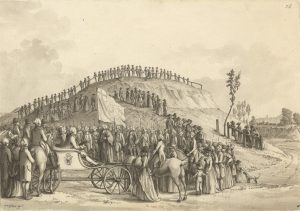The Montem Mound is Anglo-Saxon
In December 2016, a team from the Department of Archaeology, University of Reading, drilled into the Montem Mound (the Salt Hill) and removed samples of soil in order to determine its age. Analysis by radio-carbon dating determined that the mound was created during a time period spanning from 450 to 700 AD. This is an astounding finding. Previously, the most common theories of origin of the mysterious mound were a Norman motte-and-bailey or that it was prehistoric. Other earthworks dating to the early Saxon era are burial mounds, and are rare. They can be the burial place of a single high-status individual, and can contain exceptionally fine and valuable grave goods.

King George III and Queen Charlotte attending the “Ad Montem”, 1778 , S H Grimm. British Library online gallery
Grimm’s 1778 painting of George III attending the Eton College “Ad Montem” ceremony seems to show that the mound was much larger than it is today. It may be that the painter exaggerated the size. It is also possible that the original Saxon mound was enlarged later to form a motte-and-bailey (the practice of the Normans of utilising pre-existing earth-workings has only recently been identified). The mound today, however, is still large by comparison to known Saxon burial mounds, possibly indicating that if its purpose was inhumation of an individual then that person was of very high status, such as a king.
This finding gives a great deal of reinforcement to the tradition that at Cippenham there was a palace of the kings of Mercia during the heptarchy. The Montem Mound is less than a mile due east of the one of the supposed locations of the palace, near Wood Lane.





The Making History programme on Radio 4 this afternoon had as its final item the Sutton Hoo of Slough, i.e. the Montem Mound. Interesting. They asked if there might be treasure and the answer was affirmative.
I think this is the correct link to listen to the program online
http://www.bbc.co.uk/programmes/b08y0wsl
We used to dig there and found lots of very old
Bottles & pottery, which we used to sell at village
Fayres & sales. Helped boost our pocket money. We
Never found any coinage but we didn’t dig very deep
Wish I had kept some